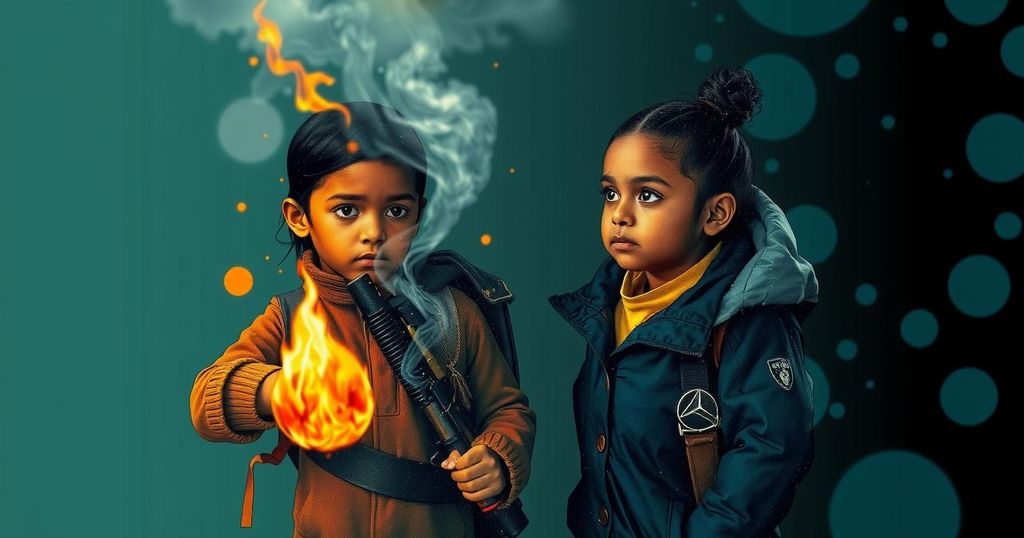Addressing Children’s Needs Amidst Climate Change and Armed Conflict

The article discusses the increasing recognition of the needs of children affected by armed conflict and climate change, as highlighted during the COP29 conference. It emphasizes the necessity for an integrated approach to policy and humanitarian efforts, addressing the links between climate insecurity, armed conflict, and children’s welfare. The Special Representative of the UN Secretary-General for Children and Armed Conflict, Virginia Gamba, calls for greater inclusion of children’s perspectives in these discussions to develop sustainable solutions.
As global conflicts continue to persist, such as those in Ukraine and Gaza, there is an increasing demand to recognize and address the specific needs of children impacted by both armed conflict and climate crises. A recent report has underscored the crucial connection between climate insecurity and serious violations against children in these situations, such as recruitment and denial of humanitarian aid. This linkage was notably presented in the Office of the Special Representative of the UN Secretary-General for Children and Armed Conflict’s 2023 study, which advocates for an integrated approach that considers both climate and child welfare in decision-making processes. At the COP29 conference held in Baku, Azerbaijan, world leaders discussed the pressing need to combine discussions on climate change with issues of armed conflict and its impacts on children. The Special Representative of the UN Secretary-General for Children and Armed Conflict, Virginia Gamba, highlighted that children continue to be disproportionately affected by both climate change and armed conflict, yet their plight often remains overlooked in critical discussions surrounding climate and security. Gamba asserted, “We must change our approach to include these children if we are seeking inclusive and sustainable solutions.” According to UNICEF’s Children’s Climate Security Risk Index, approximately one billion children live in regions where climate change exacerbates the risks of conflict-induced displacement. Furthermore, the International Organization for Migration (IOM) and UNICEF have outlined principles regarding the movement of children in the context of climate change, stressing the need to safeguard their rights amidst the challenges posed by both climate and conflict. The Special Representative urged world leaders to ensure that children affected by conflict are included in climate, peace, and security initiatives. She emphasized that adequately funding child protection measures in humanitarian responses that encompass both conflict and climate security can yield sustainable solutions. The recognition of the interconnections between these crises is vital for developing proactive and inclusive strategies for the future. In summary, it is essential for policymakers to integrate the needs of children affected by both climate change and armed conflict into broader discussions on climate and security. This approach not only fosters humanitarian support but also creates a foundation for resolving the intertwined crises facing vulnerable populations. Hearing the voices and understanding the experiences of children in conflict zones will be instrumental in designing effective interventions and ensuring their rights are upheld for a more sustainable future.
The article highlights the growing recognition of the intersection between climate change and armed conflict, particularly concerning the adverse effects on children. With multiple global conflicts ongoing, the necessity to understand and fulfill children’s needs has become more critical. Children are among the most vulnerable in these crises, facing grave issues such as recruitment into armed groups and lack of humanitarian access. The article references studies that advocate for a dual lens focusing on climate impact and child welfare in policy and humanitarian efforts.
In conclusion, the need to address the intertwined relationship between climate change and armed conflict, particularly regarding the welfare of children, is urgent. Policymakers must prioritize the voices and rights of affected children in discussions related to climate and security. By adopting an integrated approach, extending funding, and developing comprehensive strategies, stakeholders can foster solutions that protect children’s rights and ensure their needs are met in the face of both climate-induced and conflict-related challenges.
Original Source: www.ipsnews.net






